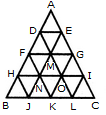Non Verbal Reasoning - Analytical Reasoning - Discussion
Discussion Forum : Analytical Reasoning - Section 2 (Q.No. 19)
19.
Count the number of parallelogram in the given figure.

Answer: Option
Explanation:
The figure may be labelled as shown.

The parallelograms composed of two components each are ADME, DFNM, EMOG, FHJN, MNKO, GOLI, HBJN, NJKO, OKLI, FHNM, MNOG, DFME, HJKN, NKLO, OLCI, FNOM, MOIG and DMGE. i.e. 18 in number.
The parallelograms composed of four components each are HOKB, NILJ, FGOH, HOLJ, NICK, FGIN, FMJB, DENH, MGKJ, MGCL, DEIO, FMLK, AENF, AGOD, DMJH, DOKF, EILM and EGKN i.e. 18 in number.
The parallelograms composed of six components each are AEJH, DAIL, DECL, DEJB, HILB and HICJ i.e. 6 in number.
The parallelograms composed of eight components each are FGKB, FGCK and AGKF i.e. 3 in number.
Total number of parallelograms in the figure = 18 + 18 + 6 + 3 = 45.
Discussion:
16 comments Page 2 of 2.
Ravi ratnakar said:
8 years ago
How many straight line are in this figure?
Shailesh said:
6 years ago
And how many quadrilaterals? How?
Parshuram khadayat said:
6 years ago
Yes, it is 27 triangle.
Roshan thapa said:
6 years ago
(N^2-1) (2n-1) /8.
27 triangle.
27 triangle.
Nehla said:
5 years ago
Yes, there is only 27 triangle. I also agree.
Kshitiz Chaudhary said:
3 years ago
1--1
1+2=3
3+3=6
6+4=10
-----------
1+3+6+10 = 20.
20+7 = 27.
=27 is the right answer.
1+2=3
3+3=6
6+4=10
-----------
1+3+6+10 = 20.
20+7 = 27.
=27 is the right answer.
Post your comments here:
Quick links
Quantitative Aptitude
Verbal (English)
Reasoning
Programming
Interview
Placement Papers